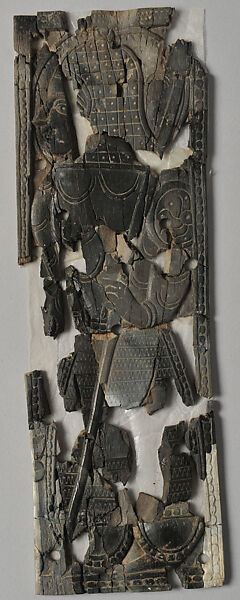Umayyad or Abbasid Ivory Plaque, mid-8th century AD, Humaymah, Jordan

Furniture Veneer Panels
first half of the 8th century
The Abbasids, a powerful Arabian family related to the Prophet Muhammad, acquired the large castle, known as al-Humayma, along the Red Sea trade routes between Damascus,
the Umayyad capital in Syria, and Islamic centers on the Arabian Peninsula circa 700.
They occupied the site until 749 when they established themselves as Caliphs in Baghdad.
On one plaque, a figure stands frontally with his head and feet in profile.
Clad in a mail apron and holding a long spear, his headgear resembles armor from Central Asia, possibly connecting al-Humayma to the Abbasid power base there.
On each of the other two plaques, an enthroned figure with bouffant hair wears a diadem around his head.
Clad in a lavish Persian-style tunic over blousy pantaloons, he sits formally on his throne, rigidly holding a vertical staff.
The plaques may have decorated a piece of furniture or a chest.
The pieces were excavated in an elaborate room decorated with frescoes across a courtyard from the main entrance to the palace complex that may have been a reception hall.
The ivories are discolored as a result of the fire that destroyed the site after the Abbasids left, possibly in the eighth century.
Object Details
Date: first half of the 8th century
Geography: Made in Probably east of the Euphrates River, excavated at al-Humayma, Jordan
Medium: Fragments of thin sheets of ivory (elephantine), now consolidated
Dimensions: Each approx: 30 x 10 x .03–.05 cm (11 13/16 x 3 15/16 x 1/100–2/100 in.)
Classification: Ivories
Credit Line: Department of Antiquities, Amman
Exhibition History
New York. The Metropolitan Museum of Art. "Byzantium and Islam: Age of Transition (7th–9th Century)," March 12, 2012–July 8, 2012.
Back to Umayyad or Abbasid Ivory Plaques, mid-8th century AD, Humaymah, Jordan